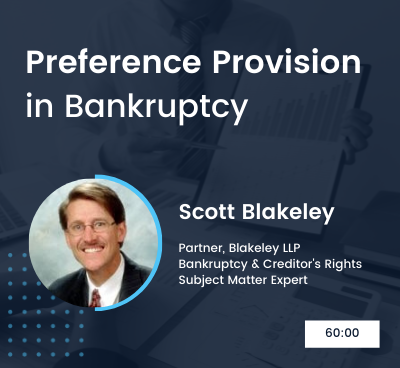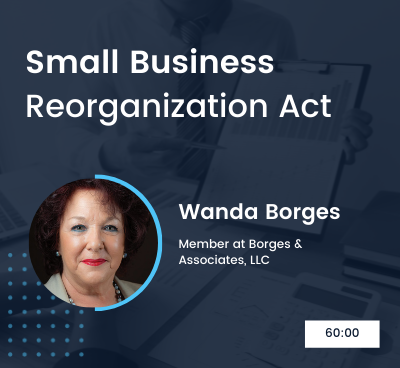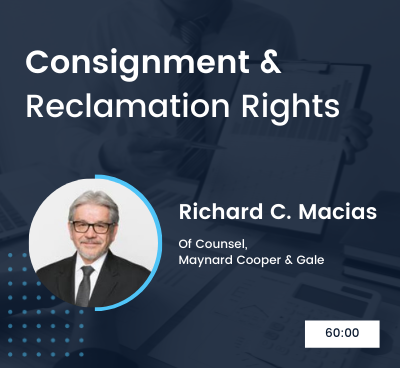There was an issue with saving this content. Please try again.
There was an issue with removing this item from your saved content. Please try again.
Please register to access Risk Mitigation Strategies Before Dealing with Preference Action.
×
Preference Provision in Bankruptcy: Keeping Your A/R Safe
Learn how preference provision defenses in the bankruptcy code could be leveraged by vendors or creditors to get some payments on A/R
About this course
| promoImage |
 |
| description |
| lessonOverview |
The Bankruptcy Code vests the trustee with far-reaching powers to avoid payments to suppliers that are received 90 days prior to a customer’s bankruptcy filing.
The purpose of the preference provision is two-fold. First, creditors are discouraged from racing to the courthouse to dismember a debtor, thereby hastening its slide into bankruptcy. Second, debtors are deterred from preferring certain creditors by the requirement that any creditor that receives a greater payment than similarly situated creditors disgorges the preference so that like creditors receive an equal distribution of the debtor’s assets. Not all transfers made within the preference period may be recaptured.
One of the most effective and commonly used preference defenses used by a vendor is the subsequent new value or subsequent advance rule, which excludes from recapture those payments to a vendor who subsequently extends goods or services (or credit for those goods or services) to the debtor. Another is the Ordinary course of business defense, in which the supplier presents evidence that payments were made in a continuing pattern prior to and during the preference period.
Among other changes, the Small Business Reorganization Act (SBRA) has made some changes to the preference defenses. Under the SBRA, the trustee now must investigate the supplier’s defenses before making the preference demand or filing suit.
Join this session with creditors’ rights and bankruptcy attorney, Scott Blakeley to learn more about it.

|
|
|
| instructor |
| name |
title |
image |
description |
| Scott Blakeley |
Partner, Blakeley LLP |
 |
Scott Blakeley is a partner at Blakeley LLP, where he advises companies regarding bankruptcy, creditors' rights, and commercial law. He was selected as one of the 50 most influential people in commercial credit by Credit Today. He is a contributing editor for the American Bankruptcy Institutes Manual of Reclamation Laws and author of A History of Bankruptcy Preference Law, published by ABI. |
|
| recommendation |
| image |
tag |
title |
description |
link |
duration |
 |
Bankruptcy |
The Small Business Reorganization Act: What it Means to the Credit Grantor |
Watch this tutorial to learn about the latest revisions made in SBRA and how to secure your receivables while dealing with small businesses. |
https://academy.highako.com/the-small-business-reorganization-act-what-it-means-to-the-credit-grantor?next=%2Fthe-small-business-reorganization-act-what-it-means-to-the-credit-grantor%2F816419 |
60 Mins |
 |
Bankruptcy |
Consignment and Reclamation in UCC, Bankruptcy Code: A Creditors Guide |
Watch this trade creditors guide on how to document and perfect consignment and reclamation under UCC and bankruptcy code. |
https://academy.highako.com/consignment-and-reclamation-in-ucc-bankruptcy-course |
60 Mins |
 |
Bankruptcy |
Attorney Insights: Riding the Bankruptcy 2.0 Wave in 2021 |
Watch this tutorial as the attorneys discuss SBRA, preference law, consignment, and reclamation rights to help a trade creditor protect their business against bankruptcy proceedings. |
https://academy.highako.com/credit-department-riding-the-bankruptcy-wave-in-2021 |
60 Mins |
|
Curriculum60 Mins
-
Trade Creditor's Role While Dealing With Preference Action (~10 Mins)
-
Trade Creditor's Role While Dealing With Preference Action
-
Bankruptcy Preference Provisions | Pre-requisites (~10 Mins)
-
Risk Mitigation Strategies Before Dealing with Preference Action
-
Bankruptcy Preference Provisions Fundamentals | Trade Creditor's Guide (~07 Mins)
-
How the Preference Game is Typically Played
-
Trade Creditor Defences in the Face of Preference LawSuit (~20 Mins)
-
Statutory Preference Defense 1- Contemporaneous Exchange
-
What is the Purpose of Bankruptcy Preference
-
Statutory Preference Defense 2- Ordinary Course of Business Defense
-
Statutory Preference Defense 3- New Value
-
Pre-Bankruptcy Strategies for a Trade Creditor (~05 Mins)
-
Steps to Take When you Receive Preference Lawsuit
-
Q&A (~15 Mins)
-
Question & Answers Segment
-
Preference Provision in Bankruptcy: Keeping Your A/R Safe
-
Final Assessment
-
-
About this course
| promoImage |
 |
| description |
| lessonOverview |
The Bankruptcy Code vests the trustee with far-reaching powers to avoid payments to suppliers that are received 90 days prior to a customer’s bankruptcy filing.
The purpose of the preference provision is two-fold. First, creditors are discouraged from racing to the courthouse to dismember a debtor, thereby hastening its slide into bankruptcy. Second, debtors are deterred from preferring certain creditors by the requirement that any creditor that receives a greater payment than similarly situated creditors disgorges the preference so that like creditors receive an equal distribution of the debtor’s assets. Not all transfers made within the preference period may be recaptured.
One of the most effective and commonly used preference defenses used by a vendor is the subsequent new value or subsequent advance rule, which excludes from recapture those payments to a vendor who subsequently extends goods or services (or credit for those goods or services) to the debtor. Another is the Ordinary course of business defense, in which the supplier presents evidence that payments were made in a continuing pattern prior to and during the preference period.
Among other changes, the Small Business Reorganization Act (SBRA) has made some changes to the preference defenses. Under the SBRA, the trustee now must investigate the supplier’s defenses before making the preference demand or filing suit.
Join this session with creditors’ rights and bankruptcy attorney, Scott Blakeley to learn more about it.

|
|
|
| instructor |
| name |
title |
image |
description |
| Scott Blakeley |
Partner, Blakeley LLP |
 |
Scott Blakeley is a partner at Blakeley LLP, where he advises companies regarding bankruptcy, creditors' rights, and commercial law. He was selected as one of the 50 most influential people in commercial credit by Credit Today. He is a contributing editor for the American Bankruptcy Institutes Manual of Reclamation Laws and author of A History of Bankruptcy Preference Law, published by ABI. |
|
| recommendation |
| image |
tag |
title |
description |
link |
duration |
 |
Bankruptcy |
The Small Business Reorganization Act: What it Means to the Credit Grantor |
Watch this tutorial to learn about the latest revisions made in SBRA and how to secure your receivables while dealing with small businesses. |
https://academy.highako.com/the-small-business-reorganization-act-what-it-means-to-the-credit-grantor?next=%2Fthe-small-business-reorganization-act-what-it-means-to-the-credit-grantor%2F816419 |
60 Mins |
 |
Bankruptcy |
Consignment and Reclamation in UCC, Bankruptcy Code: A Creditors Guide |
Watch this trade creditors guide on how to document and perfect consignment and reclamation under UCC and bankruptcy code. |
https://academy.highako.com/consignment-and-reclamation-in-ucc-bankruptcy-course |
60 Mins |
 |
Bankruptcy |
Attorney Insights: Riding the Bankruptcy 2.0 Wave in 2021 |
Watch this tutorial as the attorneys discuss SBRA, preference law, consignment, and reclamation rights to help a trade creditor protect their business against bankruptcy proceedings. |
https://academy.highako.com/credit-department-riding-the-bankruptcy-wave-in-2021 |
60 Mins |
|
Curriculum60 Mins
-
Trade Creditor's Role While Dealing With Preference Action (~10 Mins)
-
Trade Creditor's Role While Dealing With Preference Action
-
Bankruptcy Preference Provisions | Pre-requisites (~10 Mins)
-
Risk Mitigation Strategies Before Dealing with Preference Action
-
Bankruptcy Preference Provisions Fundamentals | Trade Creditor's Guide (~07 Mins)
-
How the Preference Game is Typically Played
-
Trade Creditor Defences in the Face of Preference LawSuit (~20 Mins)
-
Statutory Preference Defense 1- Contemporaneous Exchange
-
What is the Purpose of Bankruptcy Preference
-
Statutory Preference Defense 2- Ordinary Course of Business Defense
-
Statutory Preference Defense 3- New Value
-
Pre-Bankruptcy Strategies for a Trade Creditor (~05 Mins)
-
Steps to Take When you Receive Preference Lawsuit
-
Q&A (~15 Mins)
-
Question & Answers Segment
-
Preference Provision in Bankruptcy: Keeping Your A/R Safe
-
Final Assessment
-
-






